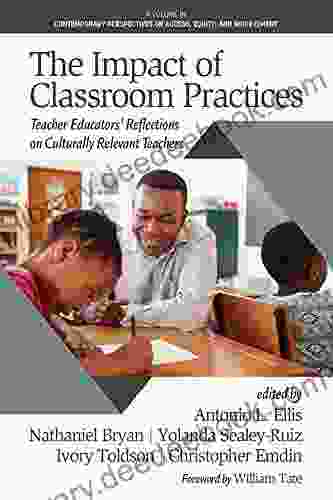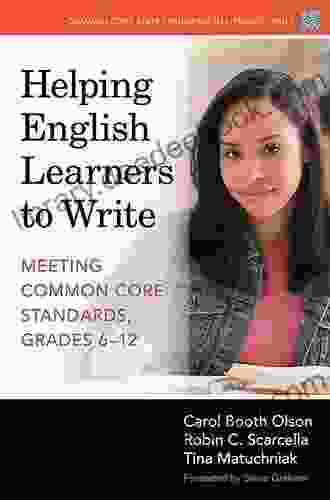Helping English Learners to Write: A Comprehensive Guide

4.4 out of 5
| Language | : | English |
| File size | : | 11165 KB |
| Text-to-Speech | : | Enabled |
| Screen Reader | : | Supported |
| Enhanced typesetting | : | Enabled |
| Word Wise | : | Enabled |
| Print length | : | 192 pages |
English learners face unique challenges in the writing classroom. They may come from diverse linguistic backgrounds, have varying levels of proficiency in English, and may struggle with academic language and writing conventions. As educators, it is our responsibility to provide these students with the support they need to succeed in writing.
Understanding the Challenges
Before we can develop effective strategies, it is important to understand the challenges that English learners face in writing.
Linguistic Differences
- English learners may come from languages with different grammar, syntax, and vocabulary.
- This can make it difficult for them to understand and produce written English.
- For example, a student from a language that does not use articles (e.g., Spanish) may struggle to use them correctly in English.
Academic Language
- Academic language is the formal language used in academic settings.
- It is different from everyday language and can be challenging for English learners to acquire.
- Academic language includes specific vocabulary, complex sentence structures, and formal tone.
Writing Conventions
- English learners may not be familiar with the conventions of English writing.
- This includes things like capitalization, punctuation, and paragraphing.
- Inconsistencies in writing conventions can make it difficult for readers to understand the student's message.
Scaffolding for Success
Scaffolding is a key strategy for supporting English learners in writing. It involves providing temporary support that gradually decreases as the student becomes more proficient.
Visual Aids
- Visual aids, such as pictures, charts, and graphs, can help English learners to understand complex concepts.
- They can also provide a visual representation of the student's ideas.
- For example, a student writing about a science experiment could use a diagram to illustrate the steps of the experiment.
Sentence Frames
- Sentence frames provide a scaffold for students to produce complete sentences.
- They can be especially helpful for students who are struggling with grammar or syntax.
- For example, a student could use the sentence frame "The main character in the story is..." to write a sentence about the protagonist of a book.
Word Banks
- Word banks provide students with a list of words that they can use in their writing.
- This can help them to expand their vocabulary and avoid using repetitive language.
- For example, a student writing about a historical event could use a word bank of vocabulary related to history.
Differentiated Instruction
Differentiated instruction is essential for meeting the individual needs of English learners.
Varying Content
- Vary the content of your instruction to match the students' interests and language proficiency levels.
- For example, you could provide more scaffolding for students who are struggling and more challenging activities for students who are more proficient.
Grouping Students
- Group students based on their language proficiency levels and learning needs.
- This will allow you to provide more targeted instruction.
- For example, you could group students who are struggling with grammar together to work on a grammar unit.
Flexible Pacing
- Allow students to work at their own pace.
- This will ensure that all students have the opportunity to master the material.
- For example, you could give students a longer deadline for a writing assignment if they are struggling with the task.
Assessment and Feedback
Assessment and feedback are essential for helping English learners improve their writing.
Authentic Assessment
- Use authentic assessment to evaluate students' writing skills.
- Authentic assessment involves assessing students on real-world writing tasks.
- For example, you could have students write an essay or a report.
Descriptive Feedback
- Provide students with descriptive feedback on their writing.
- This feedback should be specific and actionable.
- For example, instead of saying "Your essay is good," you could say "Your essay is well-organized and your arguments are supported by evidence."
Peer Review
- Involve students in peer review to provide them with feedback from their peers.
- This allows students to learn from each other and develop their critical thinking skills.
- Be sure to provide students with guidelines for peer review to ensure that the feedback is constructive.
Technology Integration
Technology can be a valuable tool for supporting English learners in writing.
Word Processors
- Word processors provide students with a variety of tools to help them write, such as spell-checkers, grammar checkers, and word prediction.
- These tools can help students to identify and correct errors in their writing.
Online Resources
- There are a variety of online resources available to support English learners in writing.
- These resources include writing prompts, grammar exercises, and vocabulary builders.
- For example, the website www.englishcentral.com provides students with access to videos, interactive exercises, and personalized feedback.
Language Learning Apps
- There are also a variety of language learning apps available.
- These apps can help students to improve their vocabulary, grammar, and writing skills.
- For example, the app DuoLingo provides students with gamified lessons in a variety of languages.
Helping English learners to write is a complex but rewarding task. By understanding the challenges that these students face, scaffolding their learning, and providing them with differentiated instruction, assessment, and feedback, we can help them to succeed in writing and achieve their full potential.
References
- Collier, V. P., & Thomas, W. P. (1997). Scaffolding instruction for English language learners: A synthesis of research on language and content instruction. NABE Journal of Research and Practice, 21(3),255-282.
- Cummins, J. (2008). The importance of language proficiency for second language learners. In J. Cummins & C. Davison (Eds.),International handbook of English language teaching (Vol. 2, pp. 415-432). Boston: Springer.
- Gibbons, P. (2006). Scaffolding language, scaffolding learning: Teaching second language learners in the mainstream classroom. Portsmouth, NH: Heinemann.
- Li, W. (2013). Scaffolding instruction for English language learners: A meta-analysis. Review of Educational Research, 83(3),510-538.
- National Council of Teachers of English. (2012). Position statement on the importance of writing instruction. Retrieved from https://www.ncte.org/statement/positions/importance-writing-instruction/
4.4 out of 5
| Language | : | English |
| File size | : | 11165 KB |
| Text-to-Speech | : | Enabled |
| Screen Reader | : | Supported |
| Enhanced typesetting | : | Enabled |
| Word Wise | : | Enabled |
| Print length | : | 192 pages |
Do you want to contribute by writing guest posts on this blog?
Please contact us and send us a resume of previous articles that you have written.
 Novel
Novel Page
Page Text
Text Reader
Reader Library
Library E-book
E-book Newspaper
Newspaper Shelf
Shelf Glossary
Glossary Foreword
Foreword Preface
Preface Synopsis
Synopsis Annotation
Annotation Footnote
Footnote Manuscript
Manuscript Codex
Codex Tome
Tome Bestseller
Bestseller Narrative
Narrative Biography
Biography Autobiography
Autobiography Memoir
Memoir Reference
Reference Narrator
Narrator Character
Character Resolution
Resolution Librarian
Librarian Borrowing
Borrowing Periodicals
Periodicals Research
Research Scholarly
Scholarly Lending
Lending Journals
Journals Reading Room
Reading Room Rare Books
Rare Books Special Collections
Special Collections Study Group
Study Group Storytelling
Storytelling Reading List
Reading List Book Club
Book Club Charles Kane
Charles Kane Dorothy Parker
Dorothy Parker Catlin R Tucker
Catlin R Tucker Manoj S Patankar
Manoj S Patankar Carter Andress
Carter Andress Benjamin Harris
Benjamin Harris Jon Scieszka
Jon Scieszka Lesley Main
Lesley Main Mckenna Johnsen
Mckenna Johnsen Robb Walsh
Robb Walsh William Hickling Prescott
William Hickling Prescott Joseph Epstein
Joseph Epstein Zarifa Ghafari
Zarifa Ghafari Katalina Ramblewild
Katalina Ramblewild Byron Edgington
Byron Edgington Michael Withey
Michael Withey Steven Mooney
Steven Mooney J Robin Maxson
J Robin Maxson Perla Bollo
Perla Bollo Nick Vandome
Nick Vandome
Light bulbAdvertise smarter! Our strategic ad space ensures maximum exposure. Reserve your spot today!

 Elmer PowellWho Is King? The Five Kingdom Biological Classification and the Biological...
Elmer PowellWho Is King? The Five Kingdom Biological Classification and the Biological...
 Glen PowellFrom Multiculturalism to Democratic Discrimination: A Critical Examination of...
Glen PowellFrom Multiculturalism to Democratic Discrimination: A Critical Examination of... Ervin BellFollow ·19.5k
Ervin BellFollow ·19.5k Alex ReedFollow ·15.5k
Alex ReedFollow ·15.5k Harry CookFollow ·14.2k
Harry CookFollow ·14.2k Jacob HayesFollow ·6.6k
Jacob HayesFollow ·6.6k Ted SimmonsFollow ·14.4k
Ted SimmonsFollow ·14.4k Lawrence BellFollow ·12.7k
Lawrence BellFollow ·12.7k Terry PratchettFollow ·7.3k
Terry PratchettFollow ·7.3k Levi PowellFollow ·14.1k
Levi PowellFollow ·14.1k

 Ralph Ellison
Ralph EllisonHealth Care Global Viewpoints: Samantha Whiskey
Samantha Whiskey is a global health...

 Gabriel Garcia Marquez
Gabriel Garcia MarquezTeacher Educators' Reflections on Culturally Relevant...
In today's...

 Levi Powell
Levi PowellSustainable Project Management: The GPM Reference Guide...
In today's rapidly changing world,...

 Isaac Bell
Isaac BellThe Captivating World of "Dreaming Awake Falling Under"
A Journey Through...

 Clarence Brooks
Clarence BrooksGovernance Regulations Valuations Mergers And...
In today's complex and ever-changing...
4.4 out of 5
| Language | : | English |
| File size | : | 11165 KB |
| Text-to-Speech | : | Enabled |
| Screen Reader | : | Supported |
| Enhanced typesetting | : | Enabled |
| Word Wise | : | Enabled |
| Print length | : | 192 pages |










